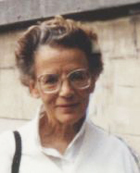The inflatable splints or URIAS® Johnstone air splints can be an invaluable aid or tool to facilitate therapy sessions in neurological rehabilitation.
They have first been developed by Margaret JOHNSTONE, FCSP (Fellowship of the Chartered Society of Physiotherapy), and her sister Ann THORP.
These two Scottish physiotherapists felt that a therapist never has enough hands to optimise the therapy time of the stroke patient. That is why they started developing the idea of group therapy-sessions, family-involvement (quite innovative in the 1960’s), autonomous practice and importing tools and aids in their practice.
The URIAS® Johnstone air splints are one of these tools; they are made of flexible PVC and blown up by mouth to a pressure of 40 mm Hg maximum. They come in different shapes and sizes. Their is a range of splints specifically developed for:
• adult stroke rehabilitation
• positioning of MS patients with leg spasticity (2 leg splints)
• children (e.g. with cerebral palsy)
They are often used dynamically in hands on therapy sessions, such as mat exercises, limb loading or weight bearing with adequate muscle alignment…, to facilitate a lot of trunk and shoulder /hip work at ‘impairment level’.
They are also used at ‘activity level’ to offer additional security and stability ranging from elbow support to knee stabilisation or ankle support.
The URIAS® Johnstone air splints are ideal for hands off work , this is when the stroke patient is invited to work by himself or under supervision only. The pressure splints give additional stability/ security and facilitate the handling (of a paralysed arm for example). They’re a key element in a typical Margaret Johnstone tool: the Law Rocking Machine.
These splints have become for many patients and therapists a precious rehabilitation-aid. The astute therapist will soon discover their use and their limits, regardless of the theoretical approach they favour. The theoretical background of the Johnstone Approach is eclectic.
In its contemporary version it is presented (since January 2007) as a PRO-Active approach to Neurorehabilitation integrating air splints and other therapy tools (PANat).
To summarise: URIAS® Johnstone air splints are developed to be used
Indoors:
During ‘hands on’ or ‘hands off’ therapy sessions (depending on the splint you use maximum 20 minutes or 1 hour at a time for adult splints – with a pressure not exceeding 40mmHg)
Biomechanical advantages:
• To influence muscle tone and length associated tissue changes
• For stabilisation and mobilisation
• For prevention and treatment of muscle contractions , especially in delayed treatment cases.
Dynamic boost to sensory input:
• used dynamically, such as during weight bearing exercises/activities, the constantly changing pressure gives additional sensory input
• weight bearing exercises also influence the proprioceptive receptors
• in combination with the intermittent pressure pump
Practical and psychological advantage:
• To allow active participation and independent practice
• To facilitate handling and to give additional stability/security
Who is Margaret Johnstone?
 Margaret Johnstone, FCSP, Scottish physiotherapist, is no stranger to most therapists working in the field of neurological rehabilitation. Her contributions to the world of stroke rehabilitation are very much appreciated by a lot of us. From early days she appreciated the importance of interdisciplinary teamwork including relatives, nurses and helpers alike. In June 1990, the Chartered Society of Physiotherapists rewarded her efforts with a Fellowship for the development and writings of a therapy approach in neurological rehabilitation with special attention for active participation of nurses, relatives and helpers.
Margaret Johnstone, FCSP, Scottish physiotherapist, is no stranger to most therapists working in the field of neurological rehabilitation. Her contributions to the world of stroke rehabilitation are very much appreciated by a lot of us. From early days she appreciated the importance of interdisciplinary teamwork including relatives, nurses and helpers alike. In June 1990, the Chartered Society of Physiotherapists rewarded her efforts with a Fellowship for the development and writings of a therapy approach in neurological rehabilitation with special attention for active participation of nurses, relatives and helpers.
Her first job was with young head injured war victims (World War II) under the inspiring direction of Prof Norman Dott. Later on, she worked for 17 years in orthopaedics. Both experiences have very much influenced her later work.
Although she is more or less of the same generation as Dr and Mrs Bobath, and some therapists try to find similarities in their respective work, MJ admits that she only started reading up about their work in the late seventies. By then she had already published herself.
As from 1965, Margaret Johnstone put a lot of her energy into the rehabilitation of long term stroke patients. She downgraded herself to a basic grade job, in order to have an opportunity to work on a long stay ward with very disabled stroke patients. Her aim was to prove that with adequate rehabilitation, those persons could get back to living in the community or at least have a life of better quality.
Invited to share her expertise, she started travelling all over the world, often with her sister Ann Thorp.
In her busy retired life, she not only took time to teach and write, but also concentrated her skills in the domiciliary physiotherapy of young head injury patients.
Margaret Johnstone published five books. Restoration of Normal Movement after Stroke (1995), is a summary and update of the previous ones. In 1996, a third edition of Home Care for the Stroke Patient was put on the market. It also became the base for a CD-ROM with home exercises to give therapists adequate support when the patient can be stimulated to do autonomous training.
All along her career, Margaret Johnstone has been wonderfully assisted and supported by her sister Ann Thorp, herself a physiotherapist. Her own merits go towards developing ideas to control limb spasticity in patients with multiple sclerosis.
Together with physios having an interest in children rehabilitation, she promoted some of Margaret’s rehabilitation ideas within the world of paediatrics.
They appointed Gail Cox Steck, physiotherapist at Burgerspital in Solothurn, Switzerland, to take on the lead as senior Instructor. Together with accredited teachers all over Europe, the original rehabilitation ideas are updated within the context of modern scientific knowledge. This process often accentuates how amazingly visionary the intuitions, creativity and the quality of MJ’s clinical work were.
The Johnstone Approach has now evolved to the PRO-Active appraoch to Nerorehabilitation integrating air splints and other therapy tools (PANat)
The aim for the 21st century and this new generation of therapists, is to find academic partnership in order to illustrate with research, what clinical experience has thought us for a long time.
Article reference taken from: www.panat.info
